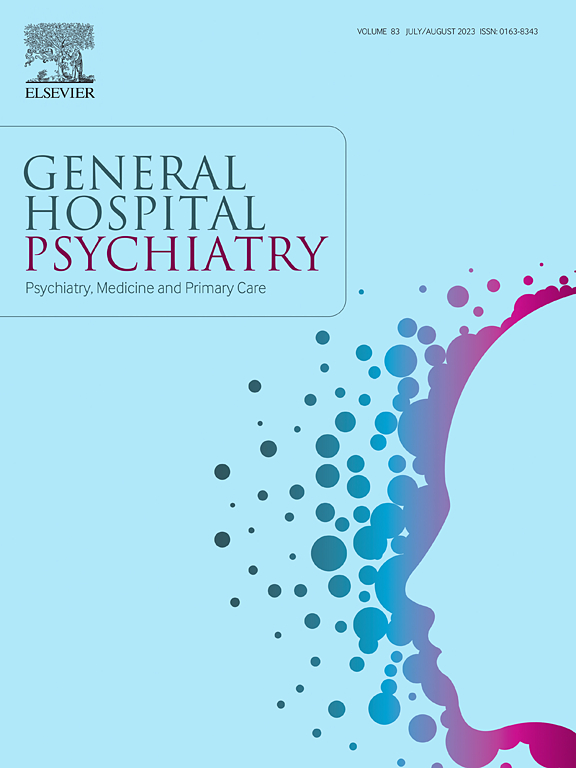开始丁丙诺啡治疗阿片类药物使用障碍后的自我伤害和过量风险
IF 3.7
2区 医学
Q1 PSYCHIATRY
引用次数: 0
摘要
目的比较服用丁丙诺啡与未服用丁丙诺啡的阿片类药物使用障碍(OUD)患者就诊后故意自残和用药过量的风险。方法来自四个卫生系统的记录确定了2012年1月1日至2019年12月31日期间13岁及以上诊断为OUD且近期未使用OUD药物的卫生系统成员的就诊记录。根据目标试验模拟方法,在7天内配发丁丙诺啡后的访问与未暴露的访问相匹配。分析比较了90天内诊断为自我伤害、伤害或中毒(主要结局)以及阿片类药物中毒和任何伤害或中毒(次要结局)的风险。结果30,955例患者就诊183,809次,其中15508例(8.4%)患者在7天内配药丁丙诺啡,2260例(1.2%)患者在90天内自残。中断丁丙诺啡治疗前的平均持续时间为44.3天(SD为32.1)。在使用逻辑回归和基线自我伤害风险调整的主要意向治疗分析中,开始使用丁丙诺啡与自我伤害(比值比[OR] 1.01, 95% CI 0.81-1.24)或阿片类药物中毒(OR 1.09, 95% CI 0.86-1.38)的显著差异无关。在检查治疗改变后结果的二次治疗分析中,丁丙诺啡起始与自我伤害风险无显著差异(风险比[HR] 0.74, 95% CI 0.53-1.02),与阿片类药物中毒风险显著降低(风险比[HR] 0.63, 95% CI 0.43-0.94)相关。结论:在OUD患者中,开始丁丙诺啡并没有降低自残风险,这可能反映了频繁停药和停药后不久自残或过量用药的高风险。这些发现加强了在开始使用丁丙诺啡的患者中提高治疗连续性的必要性。本文章由计算机程序翻译,如有差异,请以英文原文为准。
Risk of self-harm and overdose after starting buprenorphine for opioid use disorder
Objective
Compare risk of intentional self-harm and overdose after visits for opioid use disorder (OUD) followed by starting vs. not starting buprenorphine.
Methods
Records from four health systems identified visits during 1/1/2012–12/31/2019 by health system members aged 13 or older with OUD diagnosis and no recent OUD medication. Following a target-trial emulation approach, visits followed by buprenorphine dispensing within 7 days were matched to unexposed visits. Analyses compared risk of diagnosed self-harm injury or poisoning (primary outcome) as well as opioid-involved poisoning and any injury or poisoning (secondary outcomes) within 90 days.
Results
Among 183,809 visits by 30,955 patients, 15,508 (8.4 %) had buprenorphine dispensing within 7 days, and 2260 (1.2 %) had self-harm diagnosis within 90 days. Average duration of buprenorphine treatment before interruption was 44.3 days (SD 32.1). In primary intention-to-treat analyses using logistic regression and adjusting for baseline risk of self-harm, starting buprenorphine was not associated with significant difference in self-harm (odds ratio [OR] 1.01, 95 % CI 0.81–1.24) or opioid-involved poisoning (OR 1.09, 95 % CI 0.86–1.38). In secondary as-treated analyses censoring outcomes after treatment change, buprenorphine initiation was associated with no significant difference in hazard of self-harm (Hazard Ratio [HR] 0.74, 95 % CI 0.53–1.02) and with significantly lower hazard of opioid-involved poisoning (HR 0.63, 95 % CI 0.43–0.94).
Conclusions
Among people with OUD, starting buprenorphine was not followed by lower risk of self-harm, likely reflecting frequent discontinuation and high risk of self-harm or overdose shortly after discontinuation. These findings reinforce the need to improve treatment continuity among those starting buprenorphine.
求助全文
通过发布文献求助,成功后即可免费获取论文全文。
去求助
来源期刊

General hospital psychiatry
医学-精神病学
CiteScore
9.60
自引率
2.90%
发文量
125
审稿时长
20 days
期刊介绍:
General Hospital Psychiatry explores the many linkages among psychiatry, medicine, and primary care. In emphasizing a biopsychosocial approach to illness and health, the journal provides a forum for professionals with clinical, academic, and research interests in psychiatry''s role in the mainstream of medicine.
 求助内容:
求助内容: 应助结果提醒方式:
应助结果提醒方式:


